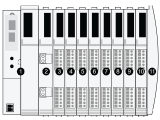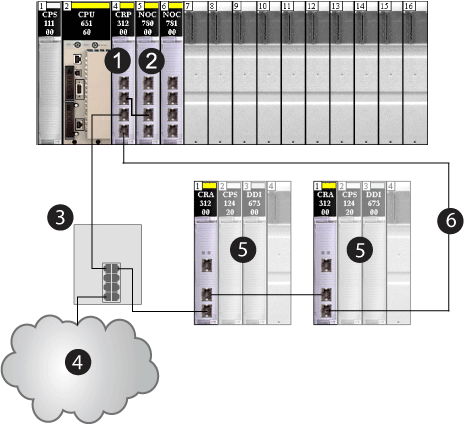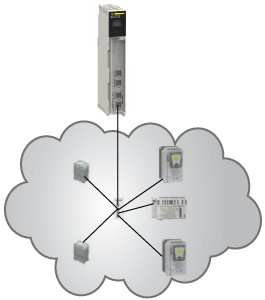Remote I/O devices and distributed I/O devices can co-exist on a device network within a Quantum EIO system.
A is an Ethernet remote I/O network that contains for example:
In this type of network, remote I/O traffic has the highest priority on the network, so it is delivered ahead of distributed I/O traffic in the event of network congestion, providing deterministic remote I/O exchanges.
DRSs connect the distributed I/O devices on the device network and provide determinism on the Ethernet remote I/O network. Download the specific predefined configuration files to these dual-ring switches, which control the data flow from distributed I/O devices so that the high priority of the remote I/O network is maintained.
In a Quantum EIO system, distributed I/O devices can be:
-
Connected to the Ethernet remote I/O network. A 140CRP31200 remote I/O head module is interlinked with a 140NOC78000 distributed I/O head module on the local rack to create a . The distributed I/O devices are connected via a DRS located on the main ring. Special types of distributed I/O devices that have 2 Ethernet ports and support may be connected directly to a . Many types of distributed I/O devices may be connected to the DRS as distributed I/O clouds.
(
Refer to the distributed I/O clouds topic to see the graphic showing the 140 CRP 312 00 head module interlinked with a 140 NOC 780 00 head module on the local rack to support distributed I/O devices.)
You can also connect distributed I/O devices that are part of an existing distributed I/O network, which you may not want to reconfigure.
-
Connect the interlink port (ETH2) of the 140NOC78000 module to the extended port (ETH1) of the 140NOC78100 module for the existing distributed I/O network to be a physical part of the Quantum EIO system. This network is called an
extended distributed I/O network.
-
Connect the interlink port (ETH2) of the 140NOC78000 module to the extended port (ETH2) of the 140NOC78100 module. The distributed I/O devices are not a physical part of the Quantum EIO device network, but they do communicate with the . This network is called an
independent distributed I/O network.
– and/or –
-
Not connected to the Ethernet remote I/O network. The devices are connected directly to a 140NOC78000 head module on the local rack as , consisting of devices such as TeSys T motor drives, islands of STB devices, SCADA and HMI devices, and PCs. If you use a device that has 2 Ethernet ports and supports RSTP, you can connect the device in a star, a daisy chain, or a ring topology. In this instance, these and are not a physical part of the Ethernet remote I/O network.
(
Refer to the distributed I/O clouds topic to see the graphic showing the 140 CRP 312 00 head module not interlinked with the 140 NOC 780 00 head module on the local rack, where there are no distributed I/O devices physically connected to the Ethernet remote I/O network.)
NOTE: Distributed I/O devices can be connected to the Quantum EIO network via DRSs or via the service ports on the 140CRP31200 head module or ••• CRA 312 00 adapter module. They cannot be connected directly to the main remote I/O ring.
NOTE: If the device, which is connected to the service port, is configured for a speed that exceeds 100 Mbps, the Ethernet link may not be established between the device and the module through the service port.
The maximum load the network can process from distributed I/O devices is:
Example of a Distributed I/O Device:
Shown throughout this documentation is an Advantys STB island. When an STB island is used with an STB NIP 2311 network interface module (NIM), the island can be connected directly to a distributed I/O sub-ring. The STB NIP 2311 NIM has 2 Ethernet ports and it supports RSTP, making it able to operate on a sub-ring.
1
STB NIP 2311 NIM
2
STB PDT 3100 (24 VDC power distribution module)
3
STB DDI 3230 24 VDC (2-channel digital input module)
4
STB DDO 3200 24 VDC (2-channel digital output module)
5
STB DDI 3420 24 VDC (4-channel digital input module)
6
STB DDO 3410 24 VDC (4-channel digital output module)
7
STB DDI 3610 24 VDC (6-channel digital input module)
8
STB DDO 3600 24 VDC (6-channel digital output module)
9
STB AVI 1270 +/-10 VDC (2-channel analog input module)
10
STB AVO 1250 +/-10 VDC (2-channel analog output module)
11
STB XMP 1100 (island bus termination plate)
A distributed I/O cloud is a group of distributed I/O devices that are not required to support . Distributed I/O clouds require only a single (non-ring) copper wire connection. They can be connected to some of the copper ports on DRSs, or they can be connected directly to 140NOC78000 modules in the local rack. Distributed I/O clouds cannot be connected to sub-rings.
When a distributed I/O cloud is connected to a DIO cloud port on a DRS in the main ring, the distributed I/O devices within the cloud are a physical part of the Quantum EIO network.
In this instance, interlink the 140 CRP 312 00 remote I/O head module with a 140NOC78000 module in the local rack, since the 140NOC78000 module manages the distributed I/O devices.
1
140CRP31200 remote I/O head module
2
140NOC78000 distributed I/O head module
3
DRS
4
distributed I/O cloud
5
remote I/O drop
6
main ring
When a distributed I/O cloud is connected directly to a 140NOC78000 module in the local rack, the distributed I/O devices are isolated from the remote I/O network.
1
140CRP31200 remote I/O head module
2
140NOC78000 distributed I/O head modules
3
distributed I/O clouds
Distributed I/O clouds contain either a single device or several devices designed in daisy chain topologies. The following example shows a distributed I/O cloud with daisy-chained devices.
Distributed I/O Sub-rings
Distributed I/O sub-rings are connected to the main ring via DRSs. They contain only distributed I/O devices that have 2 Ethernet ports and support RSTP. A distributed I/O sub-ring supports a maximum of 128 distributed I/O devices.
NOTE: You cannot combine remote I/O devices and distributed I/O devices in the same sub-ring.
The following graphic shows a remote I/O sub-ring (5) and a distributed I/O sub-ring (8).
1
140CRP31200 remote I/O head module
2
140NOC78000 distributed I/O head module
3
remote I/O drop
4
DRS configured to support a remote I/O sub-ring
5
remote I/O sub-ring
6
DRS configured to support a distributed I/O sub-ring
7
distributed I/O devices (STB island)
8
distributed I/O sub-ring
NOTE: DRSs may have different predefined configuration files to support devices in a Quantum EIO system. For details, refer to the Quantum EIO System Planning Guide.




